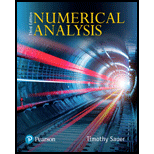
Concept explainers
a.
To find: the best order 2 least squares approximation to the data using the basic function
a.
Explanation of Solution
Given information:
The initial conditions that are given are,
here is the best order 2 least squares approximation to the data using the basic function
Calculation:
As it’s known that by using DFT equation here is the best order 2 least squares approximation to the data using the basic function
According to Theorem 10.11, the order 2 least square approximation results from dropping all but the first two terms in the trigonometric interpolating function
Therefore, the approximating function is
b.
To find: the best order 2 least squares approximation to the data using the basic function
b.
Explanation of Solution
Given information:
The initial conditions that are given are,
here is the best order 2 least squares approximation to the data using the basic function
Calculation:
As it’s known that by using DFT equation, here is the best order 2 least squares approximation to the data using the basic function
.Similar to (a).
Dropping all but the first two terms from the trigonometric interpolating function
c.
To find: the best order 2 least squares approximation to the data using the basic function
c.
Explanation of Solution
Given information:
The initial conditions that are given are, here is the best order 2 least squares approximation to the data using the basic function
Calculation:
As it’s known that by using DFT equation, here is the best order 2 least squares approximation to the data using the basic function
Similar to (a). Dropping all but the first two terms from the trigonometric interpolating function
Want to see more full solutions like this?
Chapter 10 Solutions
Numerical Analysis
- Solve questions by Course Name Ordinary Differential Equationsarrow_forward1. Graph and find the corresponding Cartesian equation for: t X== y = t +1 2 te(-∞, ∞) 42,369 I APR 27 F5 3 MacBook Air stv A Aa T 4 DIIarrow_forwardMiddle School GP... Echo home (1) Addition and su... Google Docs Netflix Netflix New folder 9. Find the area enclosed by x = sin²t, y = cost and the y-axis.arrow_forward
- 2. Graph and find the corresponding Cartesian equation for: (4 cos 0,9 sin 0) θ ε [0, 2π) 42,369 I APR 27 3 MacBook Air 2 tv A Aaarrow_forward30 Page< 3. Find the equation of the tangent line for x = 1+12, y = 1-3 at t = 2 42,369 APR A 27 M . tv NA 1 TAGN 2 Aa 7 MacBook Air #8arrow_forwardCan you cut the 12 glass triangles from a sheet of glass that is 4 feet by 8 feet? If so, how can it be done?arrow_forward
- Can you cut 12 glass triangles from a sheet of glass that is 4 feet by 8 feet? If so, draw a diagram of how it can be done.arrow_forwardUse the method of undetermined coefficients to solve the given nonhomogeneous system. x-()*+(5) = 1 3 3 1 X+ t +3 -1 -2t 1 x(t) = º1 1 e +021 e +arrow_forwardFind the general solution of the given system. 6 -(-1)x x' = -6 11 x(t) = x(t) = e5t)*[(c1 + c2(t− 1/6))(c1 + c2t)] Your answer cannoarrow_forward
- You have been hired as an intern to run analyses on the data and report the results back to Sarah; the five questions that Sarah needs you to address are given below. please do it step by step Does there appear to be a positive or negative relationship between price and screen size? Use a scatter plot to examine the relationship. Determine and interpret the correlation coefficient between the two variables. In your interpretation, discuss the direction of the relationship (positive, negative, or zero relationship). Also discuss the strength of the relationship. Estimate the relationship between screen size and price using a simple linear regression model and interpret the estimated coefficients. (In your interpretation, tell the dollar amount by which price will change for each unit of increase in screen size). Include the manufacturer dummy variable (Samsung=1, 0 otherwise) and estimate the relationship between screen size, price and manufacturer dummy as a multiple linear…arrow_forwardExercises: Find all the whole number solutions of the congruence equation. 1. 3x 8 mod 11 2. 2x+3= 8 mod 12 3. 3x+12= 7 mod 10 4. 4x+6= 5 mod 8 5. 5x+3= 8 mod 12arrow_forwardDetermine whether it's true or false and the reasoning is neededarrow_forward
- Algebra & Trigonometry with Analytic GeometryAlgebraISBN:9781133382119Author:SwokowskiPublisher:Cengage
 Linear Algebra: A Modern IntroductionAlgebraISBN:9781285463247Author:David PoolePublisher:Cengage Learning
Linear Algebra: A Modern IntroductionAlgebraISBN:9781285463247Author:David PoolePublisher:Cengage Learning Elementary Linear Algebra (MindTap Course List)AlgebraISBN:9781305658004Author:Ron LarsonPublisher:Cengage Learning
Elementary Linear Algebra (MindTap Course List)AlgebraISBN:9781305658004Author:Ron LarsonPublisher:Cengage Learning


